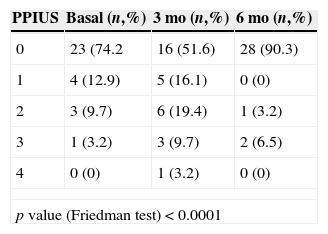To present the feasibility of photoselective vaporization of the prostate (PVP) with of a new diode laser-resection system. Surgical treatment of benign prostatic hyperplasia (BPH) is constantly evolving. Laser techniques are increasingly used in prostates of large size.
MethodsA prospective study was performed to evaluate operative data and patient outcomes with PVP using high-power diode laser (HPD) and a novel quartz-head fiber with shovel shape in patients with prostate >80ml. Demographic data, operative time, hemoglobin loss, operative results (IPSS, quality of life (QoL), Qmax, post void residue (PVR), IIEF-5 and micturition diary) and complications following Clavien-Dindo classification are described.
ResultsThirty-one patients were included in the study. Sixteen (51.6%) were on active antiplatelet treatment and 12 (38.7%) had received anticoagulants before surgery. All the cases were followed at least 6mo. No intraoperative or postoperative major complications occurred. Three patients (9.7%) had minor complications according to Clavien-Dindo classification. Twenty-seven (87.1%) were discharged on postoperative day one without catheter. There were significant improvements in IPSS, QoL, Qmax and PVR, both at 3 and 6mo (p<0.0001), but sexual function according to IIEF-5 showed no differences. Urgency (any grade) increased at 3mo (48.4%; p=0.002) and considerably decreased at 6mo (9.7%; p<0.0001).
ConclusionThis pilot experience with shovel shape fiber and HPD is encouraging. It shows that laser-resection is a safe procedure, achieving excellent results in terms of IPSS, QoL and Qmax in large prostates even in high-risk patients. Longer follow-up, comparative and randomized controlled studies are needed to widespread these results.
Presentar la viabilidad de la vaporización fotoselectiva de la próstata (VFP) con un nuevo sistema de resección de láser de diodo. El tratamiento quirúrgico de la hiperplasia prostática benigna (HPB) está en constante evolución. Las técnicas de láser se utilizan cada vez más en próstatas de gran tamaño.
MétodosSe realizó un estudio prospectivo para evaluar los datos operativos y los resultados de los pacientes con VFP utilizando láser de diodo de alta potencia (DAP) y una innovadora fibra con cabeza de cuarzo en forma de pala en los pacientes con próstata>80ml. Se describen los datos demográficos, tiempo quirúrgico, pérdida de hemoglobina, resultados operatorios (IPSS, calidad de vida [CdV], Qmáx, residuo posmiccional [RPM], IIEF-5 y micción diaria) y las complicaciones de la clasificación Clavien-Dindo.
ResultadosTreinta y un pacientes fueron incluidos en el estudio. Dieciséis (51,6%) estaban en tratamiento antiplaquetario activo y 12 (38,7%) habían recibido anticoagulantes antes de la cirugía. Todos los casos fueron seguidos al menos 6meses. No se produjeron complicaciones graves intraoperatorias ni postoperatorias. Tres pacientes (9,7%) tuvieron complicaciones leves según la clasificación Clavien-Dindo. Veintisiete (87,1%) fueron dados de alta en el primer día del postoperatorio sin catéter. Hubo mejoras significativas en el IPSS, CdV, Qmáx y RPM, tanto a los 3 como a los 6 meses (p<0,0001), pero la función sexual según el IIEF-5 no mostró diferencias. La urgencia (de cualquier grado) aumentó a los 3meses (48,4%; p=0,002) y se redujo considerablemente a los 6meses (9,7%, p<0,0001).
ConclusiónEsta experiencia piloto con fibra en forma de pala y DAP es alentadora. Esto demuestra que la resección con láser es un procedimiento seguro, logrando excelentes resultados en cuanto a IPSS, CdV y Qmáx en próstatas grandes, incluso en pacientes de alto riesgo. Se necesita un seguimiento más prolongado, estudios controlados comparativos y aleatorios para generalizar estos resultados.











